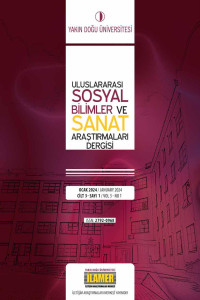Araştırma Makaleleri
Sayı Editör Kurulu


 0000-0002-1493-1784
0000-0002-1493-1784

 0000-0003-2696-7474
0000-0003-2696-7474
Amaç ve Kapsam
Uluslararası Sosyal Bilimler ve Sanat Araştırmaları dergisi; genel çerçevede tüm sosyal bilimler başlığı altındaki bilim dallarına açık olmakla birlikte özelde ise iletişim ve sanatın diğer disiplinlerle ilişkileri üzerine odaklanmıştır.
Tarihsel Üretim ve tüketim paradoksuna karşın, değişen ve dönüşen sosyo-ekonomik ve kültürel yapılanmaları mercek altına alan tüm kuramsal ve ampirik araştırmaları odağına almaktadır. Özellikle iletişim, sanat, kültür ve eğitim alanlarındaki yeni yönelimlerin ve disiplinler arasındaki iş birliğinin bilime ve toplumsal faydaya yönelik katkılarının artması amacını asal hedef olarak kabul etmektedir.
Eskiyi anlamlandırma ve değişen dünyayı sentez etme noktasından hareket eden dergi; sosyal bilimler içerisinde özellikle, arkeoloji, sanat tarihi, dil, müzecilik ve sanatın tüm dalları başta olmak üzere tüm sosyal bilimler disiplinlerini ilgi odağına taşımaktadır.
Bu alanların iletişim ile ilişkisi, iletişim alanındaki kuramsal yeni yaklaşım ve teknolojik değişimler, tüketim alışkanlıklarına bağlı olarak şekillenen sektörel yapılanmalar, iletişim eğitimindeki yüksek öğretime bağlı değişim ve dönüşümlerin yanında özellikle dezavantajlı bireylerin kişisel ve toplumsal gelişimine yönelik tüm bilim dallarını kapsayan akademik çalışmaları desteklemeyi hedeflemektedir. Toplumsal önem arz eden sağlık alanındaki çalışma huzuru ve hasta haklarını da içeren sağlık iletişimi akademik anlamda geliştirilmesi gerekli bir diğer alan olması nedeni ile ayrıca dergi tarafından önemsenmektedir.
Özellikle iletişimin en temel unsuru olarak kabul edilen dil ve bu yöndeki disiplinlere ait akademik çalışmalara da ayrıca bilimsel kriterlerin üst düzeyde karşılanması koşulu ile değerli görmektedir.
Bahsi geçen tüm bilim dallarında düzeyli akademik çalışmaların bilimsel yaşama dahil edilmesini desteklemek amacında olan dergi, genç akademisyenleri de destekleme gayesi ile ücretsiz olarak makale kabul etmekte ve yayınlamaktadır.
Yazım Kuralları
1. Makale MS Word dosyası olarak hazırlanmalıdır. Makale metninde yazılar 8.000 kelimeyi geçmemelidir. Metin, Times New Roman yazı tipiyle 11 punto yazılmalı, satır aralığı 1 pt (tek) bırakılmalıdır. Kenar boşlukları (üst 3 cm, alt 3 cm, sol 3,5 cm, sağ 2,5 cm, cilt payı 0) şeklinde ayarlanmalıdır. Başlıklar 12 punto (bold) verilmelidir. Açıklama dipnotları 9 punto ve tek satır aralığıyla yazılmalıdır. Paragraf girintileri ve aralıklar ise aşağıdaki şekilde oluşturulmalıdır:
Hizalama: İki Yana Yasla
Anahat Düzeyi: Gövde Metni
Girinti: Sol ve Sağ “0 cm”
Özel: İlk Satır “1,25 cm”
Aralık: Önce ve Sonra “6 nk”
Satır Aralığı: Tek “1 pt”
2. Makalenin başına birisi makalenin yazıldığı dilde, diğeri İngilizce olmak üzere en fazla 250 sözcüklük özet eklenmelidir. Özetler 11 punto ve tek satır aralığıyla yazılmalıdır.
3. Makalenin konusuyla ilgili olarak gerek yazıldığı dilde gerekse İngilizce olarak 3-5 arasında anahtar sözcük saptanmalıdır.
4. Makale, giriş bölümü ile başlamalı, bu bölüm yazının hipotezi, kapsamı ve amacı üzerinde durulmalı, ara ve alt başlıklarla desteklenebilecek gelişme bölümü veri, gözlem, görüş, yorum ve tartışmalarla desteklenmeli, sonuç bölümünde ise çalışmada varılan sonuçlar, önerilerle desteklenerek açıklanmalıdır.
5. Makale İçi Başlıklar: Makalede, konunun işlenişine göre rakam-harf sistemi esas alınarak ana ve alt başlıklar oluşturulmalıdır.
6. Fotoğraf, harita ve tablolar: Metnin içinde kullanılan fotoğraf, plan ve tabloların sayfa yapısının dışına çıkılmaması hususunda dikkat edilmelidir. Bu tür belgeler baskı tekniğine uygun çözünürlükte olmalı ve birden fazla ise numaralandırılmalıdır.
7. Alıntı ve Göndermeler: Alıntılar tırnak içinde ve eğik (italik) yazılmalıdır. Alıntıların yanına ya da altına APA ve dipnot tekniğiyle gönderme yapılmalıdır.
8. Kaynak göstermede dipnot tekniği ve APA tekniği kullanılmalıdır. Alıntı ve göndermeler, metin içinde uygun yere parantez açılarak yazarın soyadı, alıntı ya da gönderme yapılan eserin yayın tarihi ve alıntının sayfa numarası belirtilmelidir (bk. III. Dipnot ve Kaynakça Kuralları). Dipnot kullanımı ise sadece sınırlı sayıdaki açıklamalar için olmalı ve numaralandırılmalıdır.
9. Zorunlu hâller dışında makalelerin yazımında mutlaka Türk Dil Kurumunun güncel Yazım Kılavuzu esas alınmalıdır.
III. Dipnot ve Kaynakça Kuralları
Uluslararası Sosyal Bilimler ve Sanat Araştırmaları Dergisi’nde kullanılan kaynakça, künye düzeni, gönderme ve alıntı ile ilgili kurallar, APA (American Psychological Association- “Amerikan Psikoloji Derneği”) kuralları ve üniversitemizin “Bilimsel Yayınlar Kaynaklar Gösterme İlkeleri” temel alınarak hazırlanmıştır. Bu belgede yer almayan durumlarla ilgili olarak APA’nın Publication Manual of the American Psychological Association başlıklı yayının yedinci basımı veya APA’nın web sitesi (http://www.apastyle.org) kullanılabilir.
a) Genel Kurallar
-Yazar sayısı altıdan fazlaysa, ilk altı yazarın adları künyede verilir, altıncı yazardan sonra (vd.) “ve diğerleri” ifadesi kullanılır. Yazarların ad ve soyadları açıkça belirtilir, kısaltma kullanılmaz. Çok yazarlı yayınlarda her bir yazarın ad ve soyadından sonra noktalı virgül (;) getirilerek yazarlar birbirinden ayrılır. (bk. Kaynakça Gösterimi 1.2.).
- Yayına hazırlayan kişinin adından sonra hazırlayan(lar) yerine (Haz.), editör(ler) yerine ise (Ed.) kısaltması kullanılır.
- Dergi ve kitap adları kısaltılmadan eğik (italik) olarak yazılır.
- Bildiri kitapları kitap gibi, bildiri kitabından alınan bir bildiri de kitap bölümü gibi belirtilir.
- Danışma kaynaklarının (ansiklopedi, sözlük, biyografi vb.) belli bir kısmından yararlanılan bilgi, kitap içinde bir bölüm gibi aktarılır.
- Danışma kaynaklarında maddelerin yazarı belli değilse, madde adından giriş yapılır.
- Tezlerde tezin adından sonra yüksek lisans tezi, doktora tezi ya da sanatta yeterlilik tezi ifadeleri kullanılır. Derecenin verildiği üniversitenin adı ve yeri yazılır. Tezin basılıp basılmadığı belirtilir.
- Yasa ve yönetmeliklerde künye girişi yasanın adından yapılır. Yasanın adından sonra ayraç içinde yasanın kabul tarihi (sadece yıl olarak), künye sonunda ise yasanın yayınlandığı derginin tarihi (gün, ay, yıl olarak) belirtilir.
- Elektronik kaynaklarda temel bilgilerin yanı sıra erişim tarihi ve erişim adresi bilgileri de verilir.
- E-kaynaklarda son güncelleme tarihi yayın tarihi olarak alınır.
- Mektup, e-ileti, telefon görüşmesi gibi kişisel görüşmelerin kaynakçaya eklenmesi gerekmez, görüşmelere metin içinde gönderme yapılır.
b) Dipnot ve Kaynakça Gösterimi
1. Kitapta Gösterim
1.1. Kitap – Tek Yazarlı ise
Kaynakça Gösterimi:
Yazarın Soyadı, Adı. (Yayın Yılı). Kitap Adı. Yayın Yeri: Yayınevi.
Örnek:
Caferoğlu, Ahmet. (1993). Eski Uygur Türkçesi Sözlüğü. İstanbul: Enderun Kitabevi Yayınları.
Dipnot Gösterimi:
(Caferoğlu, 1993: s. 50)
Uyarı: Aynı yazarın aynı tarihli birden fazla yayını var ise kaynakça ve dipnot gösterimi aşağıdaki şekilde olmalıdır:
Kaynakça Gösterimi:
Caferoğlu, Ahmet. (1995/1). Anadolu İlleri Ağızlarından Derlemeler. Ankara: Türk Dil Kurumu Yayınları.
Caferoğlu, Ahmet. (1995/2). Doğu İllerimiz Ağızlarından Toplamalar. Ankara: Türk Dil Kurumu Yayınları.
Dipnot Gösterimi:
(Caferoğlu, 1995/1: s. 56), (Caferoğlu, 1995/2: s. 68)
1.2. Kitap- Çok Yazarlı ise
Kaynakça Gösterimi:
Yazar, A.; Yazar, B.; Yazar, C.; Yazar, D.; Yazar, E.; Yazar, F. vd. (Yayın Yılı). Kitap Adı. Yayın Yeri: Yayınevi.
Örnek:
İsen, M.; Horata, O.; Macit, M.; Kılıç, F.; Aksoyak, İ. H. (2005). Eski Türk Edebiyatı El Kitabı. Ankara: Grafiker Yayıncılık.
Dipnot Gösterimi:
İlk gönderme: (İsen, Horata, Macit, Kılıç ve Aksoyak, 2005: s. 57)
İkinci ve sonraki göndermeler: (İsen vd., 2005: s. 60)
1.3. Kitap Tüzelkişi Yazarlığı ise
Kaynakça Gösterimi:
Tüzelkişi. (Yayın Yılı). Kitap Adı. Yayın Yeri: Yayınevi.
Örnek:
Türk Dil Kurumu. (2005). Türkçe Sözlük (10. bs.). Ankara: Türk Dil Kurumu Yayınları.
Dipnot Gösterimi:
(Türk Dil Kurumu, 2005: s. 55)
1.4. Kitap Yazarı Yok ise
Kaynakça Gösterimi:
Kitap Adı. (Yayın Yılı). Yayın Yeri: Yayınevi.
Örnek:
Kütüphaneciliğimiz Üzerine Görüşler. (1987). Ankara: Kültür ve Turizm Bakanlığı.
Dipnot Gösterimi:
(Kütüphaneciliğimiz Üzerine Görüşler, 1987: s. 20)
1.5. Kitap Çeviri ise
Kaynakça Gösterimi:
Yazar Soyadı, Adı. (Yayın Yılı). Kitap Adı. Adı Soyadı (Çev.). Yayın Yeri: Yayınevi. (Kaynak yapıtın yayın yılı).
Örnek:
Gabain, Annemarie Von. (1988). Eski Anadolu Türkçesi Grameri. Mehmet Akalın (Çev.). Ankara: TDK Yayınları (Orijinali 1941’de yayımlanmıştır).
Dipnot Gösterimi:
(Gabain, 1941/1988: s. 70)
1.6. Kitap İçinde Yayın (Bölüm ya da Makale) ise
Kaynakça Gösterimi:
Yazar Soyadı, Adı. (Yayın Yılı). “Yayın Adı”. Adı Soyadı (Haz./Ed.). Kitap Adı. (Yayının sayfa numaraları). Yayın Yeri: Yayınevi.
Örnek:
Özkan, Nevzat. (2007). “Gagavuz Türkçesi”. Ahmet Bican Ercilasun (Ed.). Türk Lehçeleri Grameri. (s. 81-170). Ankara: Akçağ Yayınları.
Dipnot Gösterimi:
(Özkan, 2007: s. 85)
2. Makale
2.1. Bilimsel Dergi Makalesi Tek Yazarlı ise
Kaynakça Gösterimi:
Yazar Soyadı, Adı. (Yayın Yılı). “Makale Adı”. Dergi Adı, Cilt (Sayı), sayfa numaraları.
Örnek:
Daşdemir, Muharrem. (2013). “Türkçede Miktar ve Sayı Sistemi”. Turkish Studies, Sayı: 8/13, s. 309-336.
Dipnot Gösterimi:
(Daşdemir, 2013: s. 320)
2.2. Bilimsel Dergi Makalesi Çok Yazarlı ise
Kaynakça Gösterimi:
Yazar, A.; Yazar, B.; Yazar, C.; Yazar, D.; Yazar, E.; Yazar, F., vd. (Yayın Yılı). “Makale Adı”. Dergi Adı, Cilt (Sayı), sayfa numaraları.
Örnek:
Kurnaz, C.; Tatçı, M.. (1997). “Ahmed Yesevî Hakkında Bir Bibliyografya Denemesi”. Bilig, (4), s. 253-263.
Dipnot Gösterimi:
İlk gönderme: (Kurnaz, Tatçı, 1997: s. 258)
İkinci ve sonraki göndermeler: (Kurnaz vd., 1997: s. 258)
2.3. Magazin Makalesi Yazarı Belli ise
Kaynakça Gösterimi:
Yazar Soyadı, Adı. (Ay-Yıl). “Makale Adı”. Dergi Adı, Cilt (Sayı), sayfa numaraları.
Güllü, Canan. (Mart 2017). “Güçlü Ekonomi güçlü Toplumun Çimentosudur”. Popüler Yönetim, Sayı: 2, s. 6.
Dipnot Gösterimi:
(Güllü, 2017: s. 6)
2.4. Magazin Makalesi Yazarı Yok ise
Kaynakça Gösterimi:
“Makale Adı”. (Ay-Yıl). Dergi Adı, Cilt (Sayı), sayfa numaraları.
Örnek:
“Yerel Bilginin Küreselleştirilmesi”. (Nisan 2006). Focus, Sayı: 12, s. 14-17.
Dipnot Gösterimi:
(Yerel Bilginin Küreselleştirilmesi, 2006: s. 14)
2.5. Gazete Makalesi
Kaynakça Gösterimi:
Yazar soyadı, Adı. (Gün-Ay-Yıl). “Makale Adı”. Gazete Adı, sayfa numaraları.
Örnek:
Akyol, Taha. (28.02.2005). “Sosyal Bilim Ödülleri”. Milliyet, s. 21.
Dipnot Gösterimi:
(Akyol, 2005: s. 21)
3. Bildiri
3.1. Bildiri Yayımlanmış ise
Kaynakça Gösterimi:
Yazar Soyadı, Adı. (Yayın Yılı). “Bildiri Adı”. Editör (Ed.). Kitap Adı. (sayfa numaraları). Yayın Yeri: Yayınevi.
Örnek:
Börekçi, Muhsine. (2004). “Türkçe Öğretimi Bakımından Çatı Kavramı”. V. Uluslararası Türk Dili Kurultayı Bildirileri I 20-26 Eylül 2004. (s. 487-500). Ankara: Türk Dil Kurumu Yayınları.
Dipnot Gösterimi:
(Börekçi, 2004: s. 489)
3.2. Bildiri Yayımlanmamış ise
Kaynakça Gösterimi:
Konuşmacı Soyadı, Adı. (Ay-yıl). “Bildiri Adı”. Toplantı Adı, Toplantı Yeri
Örnek:
Aydemir, Yaşar. (26-27 Mayıs 2000). “Bursalı İsmail Hakkı’nın Eserlerinden Hareketle Şiir Görüşü”, I. Uluslararası İsmail Hakkı Bersavî Sempozyumu, Bursa.
Dipnot Gösterimi:
(Aydemir, 2000)
4. Danışma Kaynakları Rapor ve Tez
4.1. Danışma Kaynakları Sözlük ise
Kaynakça Gösterimi:
Yazar Soyadı, Adı. (Yayın Yılı). Yapıt Adı. Yayın Yeri: Yayınevi.
Örnek:
Pala, İskender. (2009). Ansiklopedik Divan Şiiri. İstanbul: Kapı Yayınları.
Dipnot Gösterimi:
(Pala, 2009: s. 26)
4.2. Danışma Kaynakları – Ansiklopedi Maddesi ise
Kaynakça Gösterimi:
Yazar Soyadı, Adı. (Yayın Yılı). “Madde Adı”. Yapıt Adı, Cilt (Sayı), sayfa numaraları. Yayın Yeri: Yayınevi.
Örnek:
Kutluer, İlhan. (1999). “İbn Tufeyl”. Türkiye Diyanet Vakfı İslam Ansiklopedisi, Cilt: 20, s. 142-148. Ankara: Türkiye Diyanet Vakfı Yayınları.
Dipnot Gösterimi:
(Kutluer, 1999: s. 142-148)
4.3. Rapor ise
Kaynakça Gösterimi:
Yazar Soyadı, Adı. (Yayın Yılı). Rapor Adı (Rapor No:). Yayın Yeri: Yayımlayan/Hazırlayan Kuruluş.
Örnek:
Gencel Bek, Mine. (1989). Mediscape Turkey 2000 (Rapor No: 2). Ankara: BAYAUM
Dipnot Gösterimi:
(Gencel Bek, 1989)
4.4. Tez ise
Kaynakça Gösterimi:
Yazar Soyadı, Adı. (Yayın Yılı). Tez Adı. Yüksek Lisans/Doktora/Sanatta Yeterlilik Tezi, Üniversite Adı, Yer.
Örnek:
Kotan, Hüsna. (2015). Yunus Emre Divanı’nın Söz Dizimi. Yayımlanmamış Doktora Tezi, Atatürk Üniversitesi Sosyal Bilimler Enstitüsü, Erzurum.
Dipnot Gösterimi:
(Kotan, 2015: s. 98)
5. Elektronik Kaynaklar
5.1. Elektronik Kaynak Makale ise
Kaynakça Gösterimi:
Yazar Soyadı, Adı. (Yayın Yılı). Makale Başlığı. Dergi Adı, Cilt, Sayı, sayfa numaraları. Erişim tarihi. Erişim adresi.
Örnek:
Akalın, Şükrü Haluk. (1998). “İnternetteki Türkoloji Dünyası”, Türk Dili, Sayı: 556, s. 52-69. (ET:01.04.2005). .
Dipnot Gösterimi:
(Akalın, 1998: s. 57)
5.2. Elektronik Kaynak Rapor ise
Kaynakça Gösterimi:
Yazar Soyadı, Adı. (Ay-Yıl). Rapor Adı (Rapor no). (Gün-Ay-Yıl) tarihinde http//ağ adresinden erişildi.
Örnek:
Devlet Planlama Teşkilatı. (Temmuz 2004). e-Dönüşüm Türkiye Projesi Kısa Dönem Eylem Planı: Değerlendirme Raporu (Rapor No: 2). 02 Nisan 2006 tarihinde http://212.175.33.22/kdep/raporKDEPHaziran2004.pdf. adresinden erişildi.
Dipnot Gösterimi:
(Devlet Planlama Teşkilatı, 2004)
5.3. Elektronik Kaynak Anonim Ağ Sayfası ise
Kaynakça Gösterimi:
Kaynağın Adı. Gün-Ay-Yıl tarihinde http://ağ adresinden erişildi.
Örnek:
Bilim Etiği ve Bilimde Sahtekârlık. 04 Nisan 2006 tarihinde http://www.aek.yildiz.edu.tr/bilim.htm adresinden erişildi.
Dipnot Gösterimi:
(Bilim Etiği ve Bilimde Sahtekârlık, 2006)
Etik İlkeler ve Yayın Politikası
Dergi yayın politikasında akademik ilke ve etik değerlere bağlıdır. Etik ilke ve değerlere ilişkin ulusal ve uluslararası standartlara uygun olarak yayın hayatını sürdürmektedir. Bu kapsamda, COPE (Committee on Publication Ethics) tarafından belirlenen standartlar ve YÖK "Bilimsel Araştırma ve Yayın Etiği Yönergesi"nde belirlenen esaslar dikkate alınmaktadır ( https://publicationethics.org/ https://www.yok.gov.tr/Sayfalar/Kurumsal/mevzuat/bilimsel-arastirma-ve-…).
Makale değerlendirme sürecinde kabul edilen araştırma ve yayın etiği standartlarına aykırılığı tespit edilen eserlerin yayın talebi reddedilir. Eserin yayınlanmasından sonra söz konusu aykırılığın tespit edilmesi halinde eser yayından kaldırılır. Derginin yayın politikası çerçevesinde, temel amaç, genel çerçevede tüm sosyal bilimler başlığı altındaki bilim dallarına açık olmakla birlikte özelde ise iletişim ve sanatın diğer disiplinlerle ilişkileri üzerine odaklanarak makalelere yer vermektir.
Uluslararası Sosyal Bilimler ve Sanat Araştırmaları Dergisi, Yakın Doğu Üniversitesi, İletişim Araştırmaları Merkezinin Türkçe ve İngilizce olarak, iletişim biliminin diğer disiplinler ile ilişkilerinin, farklı perspektiflerden hareketle, alana katkı sağlayacak, kuramsal temeli kuvvetli, yeni ve özgün akademik araştırmaları, yılda iki Sayı (Kış/Ocak, Yaz/Temmuz) basılı ve elektronik olarak uluslararası yayınlayan, açık erişimli (open-access), çift-taraflı kör (double-blind) hakemli ve bilimsel bir dergidir.
Değerlendirme Süreci
Uluslararası Sosyal Bilimler ve Sanat Araştırmaları Dergisi için gönderilen akademik çalışmalar, öncelikli olarak, derginin odak ve kapsamına uygunluk açısından editör kurulu ön değerlendirmesinden geçer. Uygun bulunan çalışmalar, alan editörüne aktarılarak, alana uygun belirlenecek çift hakeme değerlendirme amacıyla gönderilir. Çift Kör hakem (double-blind peer review) uygulaması geçerli olup akademik çalışma sahiplerine ait bilgiler hakem tarafından görülemez. Hakemlere biçimsellik ve orijinallik açısından incelemelerini tamamlamaları amacıyla 45 gün süre tanınır
.
Hakemlerden raporları sonucunda,
1. Başvuruyu kabul et (hiçbir düzenlemeye ihtiyaç yoktur),
2. Küçük düzenleme gerekli (Yazar kendisine belirtilen küçük düzeltmeleri yaparsa kabul edilir),
3. Büyük düzenleme gerekli (Yazar kendisine belirtilen önemli düzeltmeleri yaparsa kabul edilir),
3. Başvurusunu reddet (yazı standartların altındaysa)
Seçeneklerinden birini belirtmek durumundadır.
Hakemlerden bir “başvuruyu kabul et”, bir “başvuruyu reddet” değerlendirmesi gelmesi durumunda; makale biçimsellik ve orijinallik açısından incelenmek üzere, 3. bir hakeme gönderilir.
Daha sonra konuya ilişkin tüm değerlendirmeler yazara gönderilir. Dil ya da yazı stili standartların altındaysa biçimsel değişiklik istenebilir. Çalışmaların yayını ile ilgili son karar, editör kurulu tarafından verilir.
Yazarlara makale önerilerini yazarken yol göstermesi için derginin kullandığı tüm değerlendirme formlarını (biçim ve içerik ön değerlendirme, alan editörü ve hakem formları) dergi web sitesinden indirerek incelemeleri tavsiye edilir.
Ücret Politikası
Uluslararası Sosyal Bilimler ve Sanat Araştırmaları dergisinde makale gönderim/süreç işletim ücreti bulunmamaktadır.
Uluslararası Sosyal Bilimler ve Sanat Araştırmaları Dergisi
ISSN: 2792-0968
Makale Çağrısı – Temmuz 2024
(Cilt 3 – Sayı 1)
Değerli Bilim İnsanları ve Araştırmacılar,
Yayın hayatına 2022 yılında 1. Cilt 1. Sayısı ile başlayan Uluslararası Sosyal Bilimler ve Sanat Araştırmaları Dergisi, Ocak ve temmuz aylarında olmak üzere yılda iki yayın yapan açık erişimli çift hakem sürecine tabi uluslararası akademik bir dergidir. Dergimiz, iletişim biliminin diğer disiplinler ile ilişkilerinin, farklı perspektiflerden hareketle, alana katkı sağlayacak, kuramsal temeli kuvvetli, yeni ve özgün akademik araştırmalarla desteklendiği tarih, sosyoloji, psikoloji, felsefe, arkeoloji, sanat tarihi, davranış bilimleri, dil bilimi, edebiyat ve güzel sanatlar gibi disiplinlerine ait olan teorik ve/veya uygulamalı özgün ve derleme makaleler yayımlamaktadır. Makaleler için başvuru ve yayın sürecinde herhangi bir ücret talep edilmemektedir.
Yayın Süreci
Makalelerin süreçlerine yönelik tüm yazarlar düzenli bir şekilde bilgilendirilmektedir. Dergiye gönderilen makaleler editör kurulu ön değerlendirme süreci sonrası alan editörlerine yönlendirilerek yine alan uzmanı iki hakeme gönderilmektedir. Hakem geri dönüşleri 6-8 hafta arasında değişmektedir. Hakemlerden gelen değerlendirme raporları doğrultusunda makalenin yayımlanmasına, yazardan düzeltme istenmesine ya da makalenin geri çevrilmesine karar verilmektedir. Kabul alan makaleler sıradaki sayı için yayın sürecine girmektedir. Süreçle ilgili detaylı bilgiye https://dergipark.org.tr/tr/pub/issar adresinden erişilebilir.
Makale başvurularınızı DergiPark sistemi üzerinden https://dergipark.org.tr/tr/pub/issar bağlantısını kullanarak gönderebilirsiniz. Gönderilecek makalelerin derginin ana sayfasında yer alan “Makale Yazım Kuralları” kısmında belirtilen esaslara uygun şekilde düzenlenmesi gerekmektedir. Katkılarınız için şimdiden teşekkür ederiz.
Saygılarımızla
Uluslararası Sosyal Bilimler ve Sanat Araştırmaları Dergisi Editör Kurulu
Adres: Yakın Doğu Üniversitesi, İletişim Araştırmaları Merkezi Lefkoşa
E-Posta: issar.info@neu.edu.tr
Internet: https://dergipark.org.tr/tr/pub/issar

